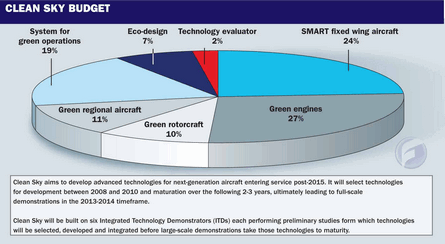Clean Sky, Europe's bid to gain the crucial competitive edge in terms of developing greener aircraft technologies of the future, always promised to be ambitious.
The scale of that ambition and the complexity of the task at hand demanded an equally impressive organisational structure. Hailed as a landmark attempt to develop public-private partnerships at European Union level further than ever before, Clean Sky will feature a far deeper and broader collaborative effort across the region, involving virtually each and every major aerospace player within Europe together with its respective supply chain.
The huge, €1.6 billion ($2.5 billion) injection of research and development funding shared between public purse and private business aims to accelerate the validation and development of new technologies, thus reducing risk and shortening the timescales in bringing them to market.
The impetus for effective and timely deployment of such an ambitious R&D programme - both in terms of scale and complexity - meant the traditional EU collaborative research framework had to be not only completely revolutionised, but also underpinned by a rulebook that was crystal clear, both for its participants and those regulating how public monies are allocated.
Working Together
Speaking at the official launch in Brussels in early February, EC research commissioner Janez Potonik explained the rationale for the collaborative effort: "The challenges that stand before us today, such as boosting international competitiveness and tackling climate change, are common to all European countries, and research is a major part of the answer. We stand a better chance to making a difference if we work together. This is the basic logic behind Clean Sky."
Another of Clean Sky's rationales is that is an exclusively European initiative. One Norwegian delegate attending the official launch asked why the USA, India and China had not been invited to address jointly the global issue of aviation's impact on the environment: "That would avoid the risk of reinventing the wheel again and again. There is a real need to co-operate," he said. Clean Sky official and Rolls-Royce research director Ric Parker was philosophical. "That goes a little bit beyond the remit of Clean Sky, but I do agree, these molecules of carbon dioxide do not recognise national boundaries.
"However," he added, "while we mustall act globally we must also act locally in terms of our competitiveness and getting the balance right will be critical. European companies must position themselves in a world where environmental credentials are increasingly valued."
He added that next year the Seventh Framework Research programme - which is already contributing c800 million of European taxpayer's money to Clean Sky - would feature a specific call for international co-operation.
Dr Marco Brusati of the European Commission, discussing Clean Sky management and governance issues, said that first calls for proposals would be issued throughout 2008 and early 2009 by the leaders of the six Integrated Technology Demonstrators (ITD).
 |
|---|
Associates Selected
Associates who, with the ITD leaders share a common seven-year commitment to contribute to joint undertaking resources, have been selected. Brusati reported Clean Sky had received 98 applications from associate candidates within 18 countries. Of these, 74 candidates from 16 countries were retained: 40% from medium and large industrial companies, 22% from small and medium-sized businesses, 22% from research organisations and 17% from universities.
Research activities will also be conducted by partners who will have limited participation in terms of duration and scope. These will be selected via calls for proposals, while subcontractors - any legal entity eligible to participate in EU research activities - will be selected via calls for tender.
"Because Clean Sky involves a heavy disbursement of public monies, financial scrutiny will be acute," confirms Brusati. The Clean Sky governing body will ultimately be responsible for this as for strategic orientation and major decisions. An executive director will head day-to-day management and six ITD steering committees, with additional groups such as a general forum, an advisory board and a national representative group that will act as an observer on the governing board.
Source: Flight International



















